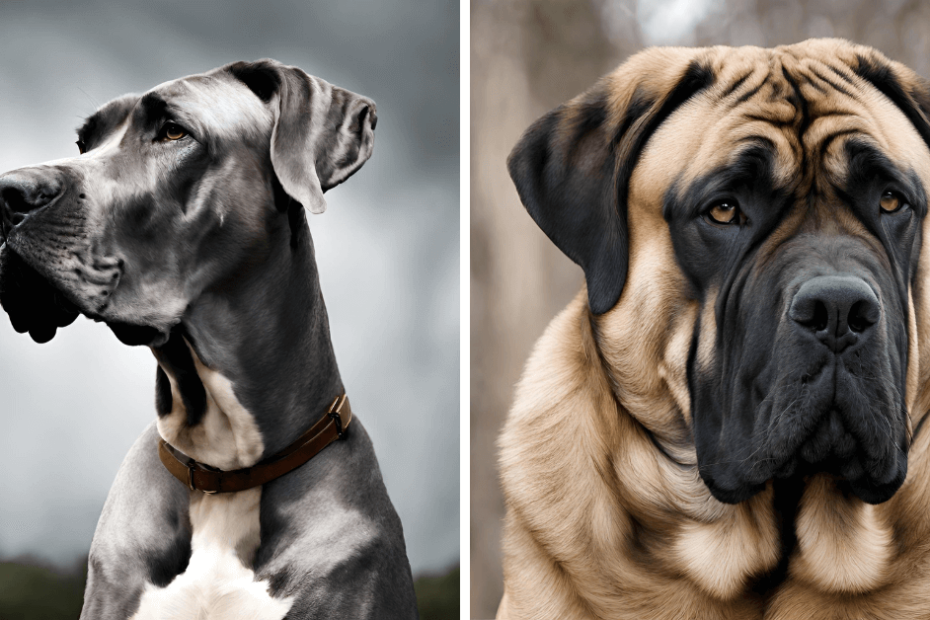Ever wondered why some dog breeds seem to age faster than others?
What if you could know which ones have the shortest time with us?
In this article, we will discover the breeds that treasure every moment a little more.
1. Dogue De Bordeaux

The Dogue de Bordeaux, often recognizable by its stocky figure and distinctive wrinkled face, has a notably shorter lifespan compared to other dog breeds.
These large, muscular dogs typically live for 5 to 8 years, a fact that potential owners should consider.
| Characteristics | Description |
|---|---|
| Average Lifespan | 5 – 8 years |
| Size | Large |
| Weight | 99 to 110+ pounds |
| Height | 23 to 27 inches (at the shoulder) |
| Temperament | Loyal, affectionate, protective |
Despite their short life expectancy, these gentle giants are known for their loyalty and affectionate nature, making them beloved companions.
They possess a protective instinct and courageous temperament, often forming a strong bond with their family.
Exercise needs are moderate for the Dogue de Bordeaux; they don’t require extensive physical activity but do enjoy regular, leisurely walks.
Apartments can be suitable for them as long as they receive adequate daily movement.
Health-wise, it’s imperative for owners to be aware that the breed can experience challenges from puppyhood and throughout its life.
Preventive veterinary care and a suitable diet are essential to manage and mitigate potential health issues.
Potential owners should also note that the Dogue de Bordeaux may prefer to be the only dog in the home and could display assertiveness around other pets.
As with any breed, early socialization and consistent training are key to ensure they become well-adjusted adults.
2. Great Dane

The Great Dane is known for its grand size and gentle demeanor. Often referred to as a “gentle giant,” this breed exhibits a friendly and patient temperament.
Despite their towering presence, they are dependable companions that display an affectionate nature.
Life Expectancy
Traditionally, Great Danes have a shorter lifespan compared to smaller dog breeds, living approximately 7 to 10 years.
Certain individuals may, however, reach the age of 12 or more, albeit less commonly.
Health Considerations
Their large size contributes to a range of health issues that potentially shorten their lifespan.
Common health problems include:
- Hip dysplasia
- Cardiomyopathy
- Gastric torsion (bloat)
Owners can support their Great Dane’s health through regular veterinary check-ups and awareness of these conditions.
Size
Height: 26 to 34 inches
Weight: 100 to 200 pounds
Great Danes are celebrated for their lofty stature, ranking among the tallest dog breeds. Caring for them requires adequate space for them to move comfortably and exercise.
Historical Role
Originally bred for hunting boar, today’s Great Danes no longer serve this purpose.
Their historical ferociousness has made way for a more serene disposition, making them well-suited to family life.
To learn more about the breed’s history and its transition from hunters to gentle home companions, readers might find the information on Love Your Dog enlightening.
3. Bernese Mountain Dog

The Bernese Mountain Dog is known for its friendly nature, striking tri-colored coat, and unfortunately, a relatively short lifespan.
On average, these gentle giants live between 7 to 10 years. Factors influencing their lifespan include size and health issues.
Size Factor
The Bernese Mountain Dog’s large size contributes to a shorter lifespan compared to smaller breeds.
They carry more body weight, which can lead to increased stress on their bodies.
Common Health Issues
Bernese Mountain Dogs have a disposition for certain health conditions such as:
- Hip and Elbow Dysplasia
- Cancer, particularly Histiocytosis
- Heart diseases
Regular check-ups and preventative care are highly recommended to identify and manage these health issues early on.
Median Lifespan: 8.4 years
4. Irish Wolfhound

The Irish Wolfhound is one of the gentle giants of the dog world, with a noble and commanding presence.
They exhibit a rough coat and are known for their towering size and courageous heart.
Their lifespan is notably shorter when compared to many other breeds.
It is essential for potential owners to be aware that an Irish Wolfhound may only live for 6 to 10 years, with an average life expectancy around 7 years.
This shortened lifespan is attributed to the fact that larger dog breeds typically have more health challenges, which might include heart disease and bone cancer.
Size
Height: Males typically stand at 32 to 35 inches, while females are slightly shorter.
Weight: A full-grown male can weigh anywhere from 140 to 180 pounds, and females generally weigh between 115 to 140 pounds.
Background
Originally bred for hunting and guarding, the Irish Wolfhound’s past was filled with the roles of war hound and royal companion.
Despite their imposing stature, these dogs are known to be incredibly loyal and affectionate with their families.
5. Neapolitan Mastiff

The Neapolitan Mastiff is recognized for its imposing stature and distinctive appearance.
They are loyal and protective companions, originating from Italy.
With a short, shiny coat, they present in colors like black, blue, mahogany, tawny, or brindle.
They have a shorter lifespan, with many living between 7 to 9 years.
| Height | Weight | Lifespan |
|---|---|---|
| 24 to 31 inches | 110 to 150 pounds | 7 to 9 years |
These gentle giants exhibit a calm and affectionate temperament, particularly toward their families.
Despite their size, they prefer to stay close to home, which makes them reliable guardians.
They can grow quite large, with males often weighing more than their female counterparts.
Neapolitan Mastiffs require consistent training and socialization due to their stubborn streak.
6. Saint Bernard

The Saint Bernard is a gentle giant renowned for its role as a rescue dog in the Swiss Alps.
These dogs have a commanding presence, coupled with a friendly nature, making them popular family pets.
They are characterized by their large size, with weights ranging from 120 to 180 pounds.
Lifespan
Saint Bernards have a relatively short lifespan, typically ranging from 8 to 10 years. Their size is a contributing factor to their shorter life expectancy.
They are prone to health issues such as hip dysplasia and heart problems, which are common in large breeds.
Care Requirements
- Exercise: Moderate; regular walks and playtime to manage weight.
- Diet: High-quality dog food tailored to large breed needs.
- Health Screenings: Regular vet check-ups to monitor for breed-specific health issues.
Given their history as rescue dogs, Saint Bernards possess a strong build and a remarkable sense of direction and resistance to cold.
Despite their ability to perform in harsh conditions, they thrive in loving home environments where they can be part of the family.
7. Scottish Deerhound

The Scottish Deerhound, recognized for its grace and nobility, is a breed characterized by a heartwarming blend of dignity and gentle demeanor.
Unfortunately, they are also known for having one of the shorter lifespans in the canine world, averaging between 8 and 11 years.
Characteristics
- Height: 30-32 inches (males), 28 inches (females)
- Weight: 85-110 pounds (males), 75-95 pounds (females)
- Physical Attributes: Deep chest, long tail, wiry coat
Health Considerations
The breed is prone to certain health conditions that can affect their longevity:
- Cardiomyopathy: Affecting the heart muscle
- Bone Cancer (Osteosarcoma): Common in larger breeds
- Bloat (Gastric Dilation): Can be life-threatening without prompt attention
Care Strategies
To support their health, the following are recommended for Scottish Deerhound owners:
- Regular Vetting: Annual check-ups to monitor heart health and other potential issues.
- Appropriate Exercise: Enough to maintain fitness but without excessive strain.
- Diet Management: A balanced diet to prevent obesity, which is harmful to their joints and general health.
Despite their short life expectancy, Scottish Deerhounds make loyal and loving companions.
Their owners often find the rewards of sharing life with these magnificent dogs well worth the heartache of their potentially abbreviated time together.
8. Bulldog

The Bulldog, known for its loose, saggy skin and distinctive pushed-in nose, is a breed with a rich history and is often associated with British culture.
Sadly, they are also recognized for having one of the shorter lifespans among dog breeds, usually ranging from 8 to 10 years.
Characteristics
- Weight: 40-50 pounds
- Height: 14-15 inches
- Personality: Docile, willful, friendly
Health Challenges
Bulldogs face several health issues which may affect their longevity.
They are prone to breathing difficulties due to their brachycephalic facial structure.
It’s essential to monitor their exercise, especially in hot weather, to prevent overheating. Bulldogs often struggle with:
- Hip dysplasia
- Heart conditions
- Skin infections
Despite their health predispositions, Bulldogs are beloved for their gentle disposition and loyalty.
9. Bullmastiff

The Bullmastiff is a formidable breed known for its strength and loyalty.
Average lifespan: 7 to 9 years
They typically showcase an affectionate nature towards their families, which contrasts with their original role as powerful guard dogs.
Despite their size, Bullmastiffs are generally gentle and good-natured.
Health Concerns
Unfortunately, the Bullmastiff’s impressive size contributes to a variety of health issues. They often face bone and joint diseases such as hip dysplasia.
They also have a predisposition for cancer, which can affect their longevity.
10. Rottweiler

Rottweilers are a robust and strong breed, known for their loyalty and protective nature.
They have a shorter lifespan compared to some other breeds.
- Average Lifespan: Typically, Rottweilers live between 8 to 10 years.
- Health Challenges: They are prone to certain health issues that can impact their longevity. Major concerns include hip dysplasia, osteosarcoma (bone cancer), and heart problems.
Despite the challenges associated with their health, many Rottweilers live fulfilling lives as both family companions and in various service roles.
With appropriate care, some Rottweilers have been known to exceed their expected 13 years and above.




